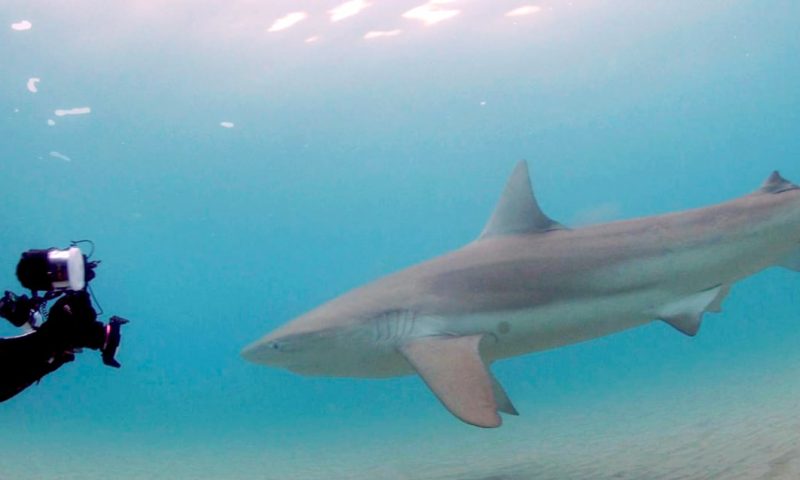The annual appearance of the animal is puzzling scientists and drawing curious onlookers.
JERUSALEM – FOR DECADES it has been a secret shared among fishermen that during the winter sharks congregate near a power plant on the shore of the Mediterranean in the northern Israeli town of Hadera.
With the sharks easy to fish in the shallow water, fishermen would often catch them at night and then find a market for the cheap protein-rich meat among Palestinians, as Israeli conservation law has banned the fishing of sharks in its waters since 2005, and Jewish dietary laws do not classify the predator as kosher, according to Adi Barash. A doctoral student at Haifa University, Barash has interviewed dozens of fishermen to try to understand what brings dozens of sharks to the coast of Israel each winter, a phenomenon also observed by scientists during the last few years.
“We really don’t know exactly why they come, but we think it has something to do with the warm water discharged by the power plant,” says Barash, who also heads the non-profit awareness and conservation group Sharks in Israel.
With relatively little known about Mediterranean sharks, whose numbers have declined by nearly 90% during the past 50 years mainly due to overfishing, this small section of coast in Israel is emerging as a key place to learn more, attracting researchers from around the world, as well as curious onlookers. It is the only place in the region where sharks have been observed in such large groups so close to the shore, says Aviad Scheinin, who heads the top predators division at Haifa University’s Morris Kahn Marine Research Station.
But the clock is ticking. The coal-fired power station, which makes the water around it up to 18 degrees Fahrenheit warmer, is expected to reduce its workload significantly over the next few years as Israel begins to make more of its electricity from natural gas.
“It is a totally man-made situation that is bringing them here, there is nothing natural about it, but it should be treated like gold,” Barash says.
A Rare Opportunity for Scientists
The sharks that spend the months of November through May here are male members of the endangered Sandbar species, and females belonging to the rare Dusky species, according to researchers from Haifa University, who have tagged and taken blood and tissue samples from 52 sharks here since 2016.
“It is interesting that females of one species congregate along with males of another species,” says Eyal Bigal, a doctoral candidate at Haifa University and manager of the top predatory lab, who works on the shark project.
The researchers also found that the sharks don’t just congregate by the Hadera power station, but also spend time at other pockets of warmer water along Israel’s coast, Bigal says.
Many of the same sharks tend to return each year, he says. And according to the few sharks they have been able to track through geotags, they likely swim outside of Israeli waters during the summer months, Bigal says. In addition to the warm water from the power plant, researchers are looking into whether other factors, such as strictly enforced fishing regulations, are contributing to the sharks gathering here.
Because so little is known about sharks in the Mediterranean, due to the difficulty of tagging them, anything the researchers learn is valuable and could contribute to more effective measures to protect sharks, Bigal says.
“An analysis of threat levels has revealed the Mediterranean as a key hotspot of extinction risk,” says Ali Hood, director of conservation at the The Shark Trust, a British non-profit that studies and promotes the conservation of sharks.
Sharks are important for a healthy marine environment because they eat weak and sick fish and prevent non-native fish from taking up residence in the sea, the researchers say. With so many sharks congregating just a few minutes away from their research station, the Haifa team is also developing new methods for studying sharks, including drone-and acoustic-based monitoring systems.

A Teaching Moment for the Public
The sharks are also drawing many curious onlookers, eager to catch a glimpse of them from the beach, or by swimming in the water. In November, Israeli media reported that a shark bit off a diver’s flipper, luckily leaving the diver uninjured. Officials declined to comment further on the incident.
“It has been terrible, with people trying to feed them, fish them and dive with them,” says Yigael Ben Ari, head of the marine law enforcement unit of the Israel Nature and Parks Authority. The government agency has opened an information booth on the beach to teach the public about the importance of sharks to the environment, and has posted signs warning people not to swim in the area.
“So we are trying to make the best of the situation, and educate people,” Ben Ari says. We have here a very unusual opportunity to meet the biggest predator in the ocean. Who wouldn’t want to see that?”
Barash welcomes the rising public interest, and is optimistic the number of sharks will increase in the waters off Israel, the only country in the region that now bans fishing all sharks, not just certain species.
“But I am afraid with so many people coming to try to see them that there will be an accident, and it will seem more legitimate to kill sharks,” Barash says. “And the Mediterranean is already the worst place in the world to be a shark because there is such a high chance of them being caught by fishing.”

